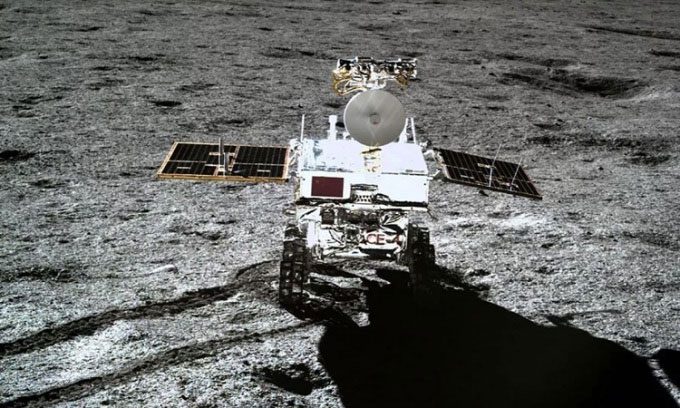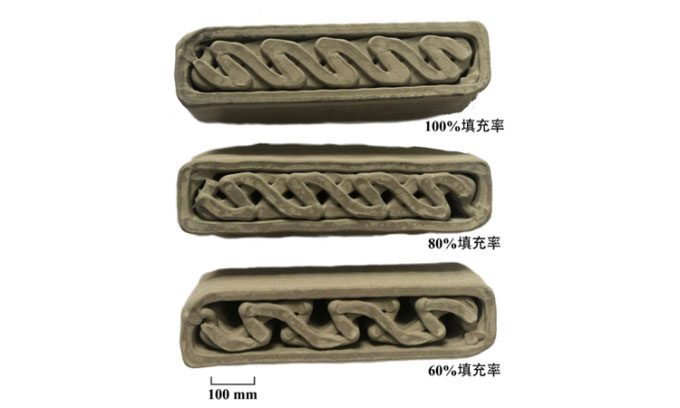A Research Team at Beihang University Improves Old Materials and Combines Them with 3D Printing Technology to Build Roads on the Moon in the Future.
Chinese scientists are developing and testing highway construction technology on the Moon, SCMP reported on May 13. The new research was published in the China Journal of Highway and Transport.

China’s Jade Rabbit 2 rover captured from the Chang’e 4 lander. (Photo: CNSA)
“I often dream of building a road on the Moon”, Zhou Siqi, the lead author of the study and a graduate student at the School of Transportation Engineering and Science at Beihang University, shared. She also mentioned that despite using complex technologies, the scene at the construction site could be quite simple, with a robot using one arm to scoop lunar dust and the other to stack bricks.
Under the guidance of Professor Li Feng, Zhou and her colleagues examined geopolymer materials discovered in the 1950s to address the challenge of building infrastructure on the Moon.
Soviet scientist Viktor Glukovsky accidentally discovered this material—initially referred to as “soil cement”—during a physicochemical reaction that transformed soft rock powder into a hard, ceramic-like material. Unlike conventional cement, which requires a large amount of water, geopolymer only needs a small quantity to stimulate the reaction between rock powder and sodium hydroxide—a cheap chemical used for unclogging dirty pipes.
As the bricks harden, the chemical process releases all the water molecules to be collected and reused in the next stage of the production cycle. This makes road construction between stations on the Moon feasible.
Researchers worldwide have proposed various methods over the past decades for building infrastructure on the Moon, including melting lunar dust at extremely high temperatures and extracting sulfur from the surface layer to make cement.
However, some space scientists argue that these issues are too difficult to solve. Instead, they suggest looking for more practical alternatives, such as creating mobile stations, rock transportation systems, robust vehicles, and even cable cars.

Geopolymer paving bricks made using 3D printing technology can be used to build roads on the Moon. (Photo: Beihang University)
Zhou’s research team combined old materials with modern 3D printing technology and experimented with simulated lunar soil to find the right formula for a highway on the Moon. This road needs to provide a fast, safe, and dust-free travel experience. Fine lunar dust not only causes wheels to slip but can also obstruct solar panels and damage equipment.
The lunar rovers from the Apollo missions only achieved speeds of 18 km/h on relatively flat terrain. An unmanned vehicle, such as China’s Jade Rabbit, must crawl at speeds below 200 meters per hour to avoid craters or rocks.
The research team at Beihang University stated that preliminary research results indicate that road construction on the Moon could be feasible. They also encountered some challenges, such as adding too much water, which made the final product too soft, while too little water caused it to stick and jam the printer. They also found that producing geopolymer at different times of the day affected quality due to temperature fluctuations.
Zhou noted that it takes about 20 minutes to produce a brick in the lab using a 3D printer the size of a desktop computer, but this process would be much faster with a large-scale printer. A well-designed hollow structure would also help save materials and increase productivity.
According to the expert team, sodium hydroxide accounts for less than 1% of the required materials. It can be sourced from Earth or produced directly on the Moon, where there is an abundance of sodium. The research team also found that adding 1/3 gram of water to each gram of lunar soil at a temperature of 80 degrees Celsius would make the bricks strong enough for road construction without clogging the printer.
However, Zhou’s ambition to build roads on the Moon faces a significant challenge. “We are not sure if there is water on the Moon,” she said.
Remote sensing data and computer models have indicated that ice exists at the bottom of some deep craters that are always in shadow near the Moon’s south pole. In the coming years, China plans to conduct several robotic explorations in this area to search for direct evidence.
China has been collaborating with Russia to build an international research station on the Moon for about a decade, but the first step will be to identify water sources. A space nuclear reactor capable of producing one megawatt of electricity is also being developed to provide abundant and stable energy for lunar settlements.





















































